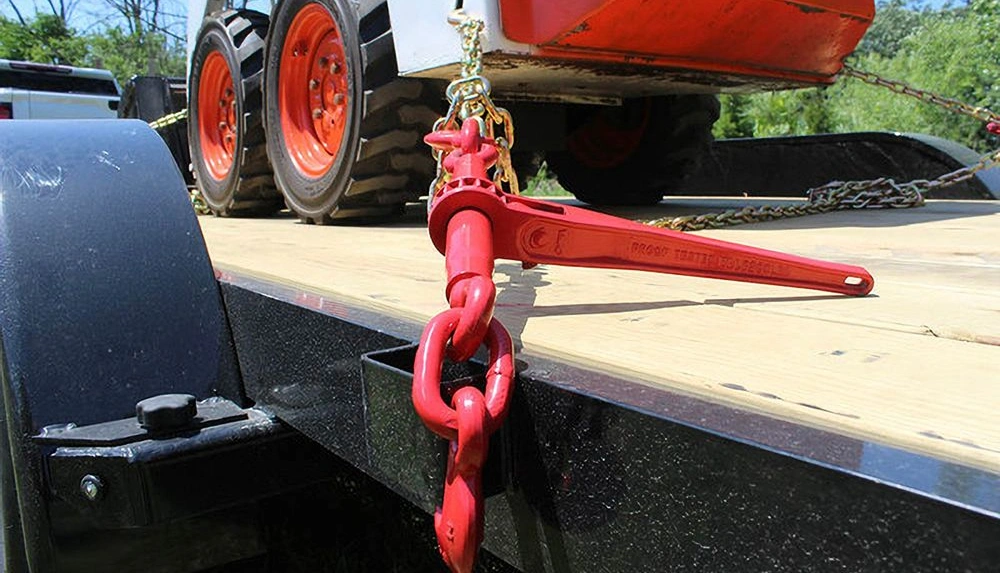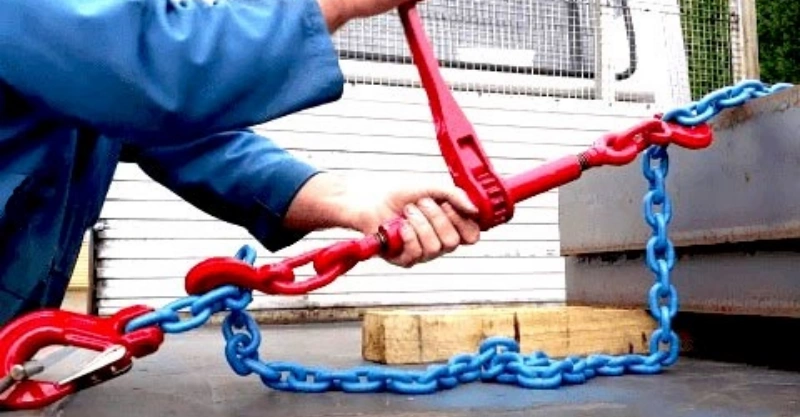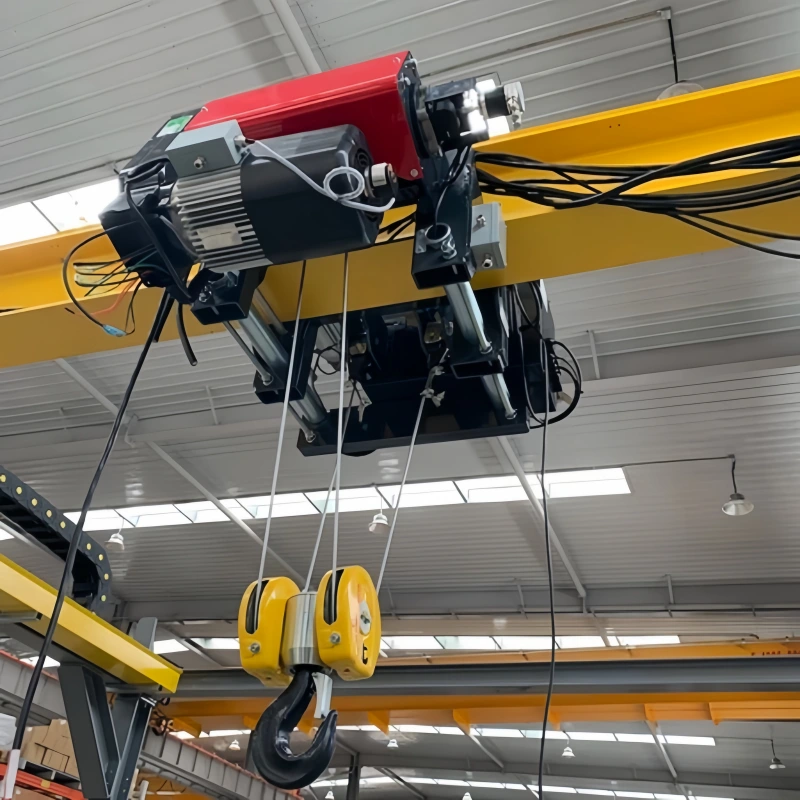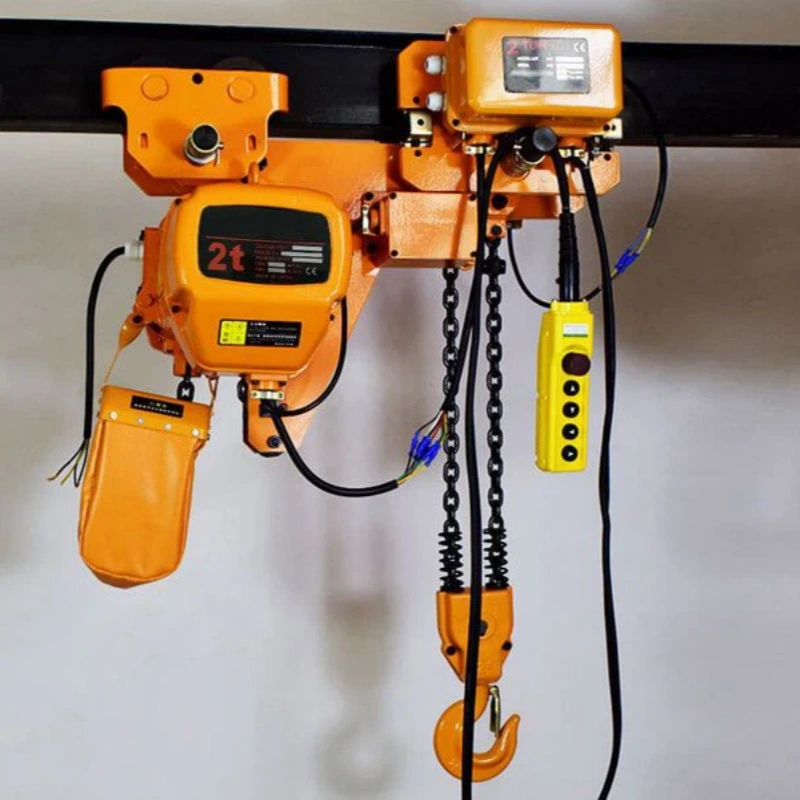You handle heavy cargo with responsibility and skill. When you use chain binders and load securement, you protect your load and everyone on the road. Always select the right binder and inspect your equipment for damage.
Follow strict safety protocols and meet all regulations. Trusted brands like Powerful Machinery offer certified Load Binders that maximize reliability and safety for your cargo operations.
Key Takeaways
Chain binders secure heavy cargo during transport, preventing shifting and ensuring safety on the road.
Always match the size and type of chain binder to your cargo’s weight for maximum safety and compliance.
Regularly inspect your chains and binders for wear or damage to maintain reliability and avoid accidents.
Choose the right type of binder—lever or ratchet—based on your cargo needs for better control and efficiency.
Using certified products like Powerful Machinery Load Binders enhances safety and meets industry standards.
Chain Binders and Load Securement
What Are Chain Binders?

Chain binders are specialized tools you use to secure chains around cargo during transportation. You operate them by attaching hooks to each end of the chain and using a central handle to apply tension.
This process keeps your load stable and prevents movement on the trailer. Chain binders come in different shapes and sizes, each designed to deliver effective tensioning for various cargo types. Many models include safety features that help you maintain control and reduce risk during operation.
You use chain binders to tighten chains and keep cargo from shifting or falling.
The central handle allows you to apply the right amount of tension for secure transport.
Safety features on modern binders help you avoid accidents and ensure proper load securement.
Why Use Chain Binders for Heavy Cargo?
You face unique challenges when transporting heavy cargo. Chain binders and load securement play a critical role in keeping your shipment safe. Without proper tension, heavy loads can shift, causing damage or creating hazards on the road. Chain binders give you the control needed to lock down large, bulky items.
You rely on them to maintain stability, especially when hauling steel, machinery, or construction materials. Using the right binder helps you meet industry standards and protect your investment.
Tip: Always match the binder size and type to your chain and cargo weight for maximum safety.
Powerful Machinery Load Binders Overview
Powerful Machinery stands out as a trusted provider of chain binders and load securement solutions. You benefit from their certified products, which deliver strength and reliability in demanding environments. Users report significant time savings when using Powerful Machinery Load Binders, especially in steel hauling.
One trucker noted that these binders cut an hour off their daily workload, allowing for more loads to be moved. You can count on these binders for consistent performance, as users have not experienced breakages or failures. Powerful Machinery’s commitment to quality ensures you get dependable tools for every job.
Feature | Benefit |
|---|---|
High-strength steel | Handles heavy cargo |
Certified safety | Meets industry standards |
Reliable design | Reduces risk of failure |
You improve efficiency and safety when you choose Powerful Machinery Load Binders for your chain binders and load securement needs.
Types of Chain Binders

When you secure heavy cargo, you choose from several types of chain binders. Each type offers unique advantages for different hauling needs. Understanding these differences helps you select the right tool for your job.
Lever Chain Binders
Lever chain binders, also called snap binders, use a simple lever action to tighten chains. You attach the hooks to each end of the chain and pull the handle to apply tension.
This design gives you quick operation and immediate feedback. Many truckers prefer lever binders for their speed. However, you must use caution. The sudden release of tension can cause kickback, which may lead to injury if you do not follow safety protocols.
Ratchet Chain Binders

Ratchet chain binders use a ratcheting mechanism to tighten chains gradually. You turn the handle back and forth, increasing tension with each motion. This method gives you more control and reduces the risk of sudden release.
Ratchet binders work well for heavy loads that require precise tensioning. You benefit from added safety and less physical strain compared to lever binders.
Adjustable and Recoilless Binders
Adjustable and recoilless binders represent the latest advancements in load securement. These binders eliminate the risk of kickback and reduce physical effort.
You adjust the tension smoothly, which improves both safety and efficiency. Many models standardize the securement process, allowing you to lock down loads in seconds.
Advantage | Adjustable and Recoilless Binders | Traditional Binders |
|---|---|---|
Safety | Reduces driver injuries by eliminating physical strain | High injury risk due to manual operation |
Efficiency | Standardizes securement, reducing load times to seconds | Unpredictable load times, causing delays |
Operational Costs | Lowers costs by minimizing overtime and idle time | Higher costs due to inefficiencies |
Note: Adjustable and recoilless binders help you work faster and safer, especially when you handle multiple loads daily.
Powerful Machinery’s Product Range and Features
Powerful Machinery offers a full line of chain binders to meet your needs. You find lever, ratchet, and advanced binders in their catalog. Each binder uses high-strength steel and features corrosion-resistant coatings. You can select from several sizes to match your chain and cargo requirements.
Chain Binder Size | Working Load Limit (WLL) |
|---|---|
5/16″-3/8″ | 6,600 lbs |
3/8″-1/2″ | 9,200 lbs |
1/2″-5/8″ | 13,000 lbs |
Recent innovations, such as integrated locking mechanisms, prevent accidental release under tension. You benefit from stronger, lighter, and more durable binders. These features give you greater load security and peace of mind on every haul.
How to Use Chain Binders Properly?
Choosing the Right Equipment
You must select chain binders and transport chains that match the demands of your heavy cargo. Begin by measuring the dimensions of your load. Consider the length, width, and height. Assess the total weight and review the working load limit (WLL) for each binder and chain.
Always match the chain size and binder type to the cargo weight. The weakest link principle applies—your system is only as strong as its lowest-rated component.
Review the cargo’s weight and length before choosing binders for trucks.
Use ratchet or lever binders based on the type of cargo and your operational needs.
Federal regulations guide the number of binders required. For chains up to 5 feet, use one binder. For chains between 5 and 10 feet, use two binders.
Most vehicles require four load binders to secure cargo at all corners.
Powerful Machinery Load Binders offer a range of sizes and types, ensuring you meet safety standards and operational requirements.
Tip: Always check the manufacturer’s specifications for working load limits before selecting your equipment.
Inspecting Chains and Binders
You must inspect your chains and binders before every use. Look for signs of wear, rust, broken links, or deformation. Clean chains and binders to remove dirt and grime. Lubricate moving parts to ensure smooth operation. Store your equipment in a dry place to prevent corrosion.
Inspection Checklist | Action Required |
|---|---|
Rust or corrosion | Clean and lubricate or replace |
Broken or frayed links | Replace immediately |
Deformed hooks or handles | Do not use; replace |
Dirt and debris | Clean thoroughly |
Note: Replace any damaged equipment immediately to maintain safety and reliability.
Securing Heavy Cargo Step-by-Step
You must follow a systematic process to secure cargo with chain binders. This ensures stability and safety during transport.
Determine the weight of your heavy cargo and select the appropriate number of chain binders based on working load limits.
Choose the binder type—ratchet or lever—according to your cargo’s needs.
Attach the chain binder securely to the cargo, making sure the hooks are properly engaged.
Tighten the binder until the cargo is snug. Avoid overtightening, which can damage the load or equipment.
Double-check all binders and chains to confirm they are secure before transport.
🚚 Always ensure even load distribution across your trailer to prevent shifting and maintain control.
Safety Tips and Common Mistakes
You must prioritize safety when using chain binders. Occupational safety organizations recommend regular cleaning, lubrication, and inspection of all equipment. Avoid using improperly sized chains or worn binders. Ensure even load distribution to prevent common errors.
Common Mistakes | Prevention Strategies |
|---|---|
Choosing the wrong type of binder chain | Match the chain or sling to the load |
Ignoring safe working load limits | Check for damage and wear protective gear |
Not conducting regular inspections | Inspect for rust, broken links, or frayed areas |
Storing chains in wet or harsh conditions | Keep chains dry, clean, and covered |
Improper binding or lifting techniques | Ensure correct training to prevent overload and shifting |
Alert: Proper training and regular inspection reduce the risk of accidents and equipment failure.
Powerful Machinery Load Binders deliver reliability and safety for every haul. You protect your investment and secure cargo when you use certified products and follow best practices.
Regulations and Compliance
FMCSA and DOT Rules
You must follow strict safety regulations when securing heavy cargo for transport. The Federal Motor Carrier Safety Administration and the Department of Transportation set clear rules for load securement. These rules require you to use securement systems that prevent cargo from moving.
You need to use chains, ropes, and binders designed for this purpose. Each component must have a working load limit that matches or exceeds the force expected during transit.
Securement systems must include vehicle parts like headboards and anchor points.
You must use securing devices such as chains and binders to hold cargo in place.
The working load limit (WLL) is the maximum safe force for any component.
Tie-down requirements change based on cargo length and weight.
If you do not comply with these safety regulations, you risk penalties from the Federal Motor Carrier Safety Administration, legal liabilities, and even out-of-service orders. Fines and lawsuits can follow if cargo is not properly secured.
Tie-Down Requirements
You need to know the minimum tie-down requirements for your cargo. The number of tie-downs depends on the length and weight of your load. Use this table as a quick reference:
Cargo Length (ft) | Weight (lbs) | Minimum Tie-Downs Required |
|---|---|---|
Less than 5 | Less than 1100 | 1 |
Less than 5 | Over 1100 | 2 |
Over 10 | Any weight | 2 for the first 10 ft + 1 for each additional 10 ft |
Any length | Held back by specific systems | 1 for every 10 ft or more |
Powerful Machinery load binders meet or exceed all industry standards for working load limits. You can trust these products to help you comply with every regulation and keep your cargo secure.
Documentation and Training
You must complete proper training in cargo securement to reduce risks. Familiarity with the North American Cargo Securement Standard is essential. You should keep documentation that proves you have received training and understand tie-down requirements for different cargo types.
Training in cargo securement reduces the risk of accidents.
You must know the standards and requirements for each type of cargo.
Keep records of your training and securement procedures.
Tip: Regular training and up-to-date documentation help you avoid costly mistakes and ensure compliance with all safety regulations.
Maintenance and Inspection
Regular Checks
You must inspect your chain binders and chains before every use. Look for visible damage, deformation, or signs of wear. Check that hooks and ratchet mechanisms work smoothly.
Clean off any dirt or debris that could interfere with performance. Schedule routine inspections to catch issues early and prevent failures on the road. Regular checks help you avoid costly downtime and ensure your equipment meets safety standards.
Tip: Implement a preventive maintenance program with scheduled inspections and lubrication to extend the life of your gear.
Cause of Failure | Prevention Strategy |
|---|---|
Inadequate Lubrication | Use high-quality lubricants and maintain lubrication systems. |
Chain Misalignment | Inspect and align chains and sprockets regularly. |
Overloading and Excessive Tension | Use chains rated for your load and adjust tension properly. |
Corrosion and Environmental Damage | Clean and protect chains with anti-corrosion lubricants. |
Improper Tensioning | Follow manufacturer guidelines for tensioning. |
Wear and Fatigue | Replace worn chains after inspection. |
Poor Maintenance Practices | Schedule regular maintenance and checks. |
Lubrication and Storage
Proper lubrication and storage keep your chain binders performing at their best. You should clean chains before applying lubricant to remove impurities. Use a lubricant with the right viscosity so it penetrates critical areas and forms a protective film.
Apply oil to the upper edges of link plates or sidebars, letting gravity help distribute it. Check oil levels in lubrication systems to prevent overheating and ensure smooth operation.
Clean chains and binders before lubrication.
Use lubricants designed for industrial chains.
Apply oil to key areas for maximum protection.
Store equipment in a dry, covered space to prevent rust and corrosion.
Maintain oil levels and inspect lubrication systems regularly.
Note: Storing your equipment properly and keeping it lubricated reduces wear and extends its lifespan.
When to Replace Equipment?
You must know when to replace chain binders and chains to maintain safety. Watch for visible damage, thinning, or worn marks. If the ratchet mechanism does not work smoothly, lubricate or replace it. Replace any rusted or deformed components immediately.
Indicator | Action Required |
|---|---|
Visible damage or deformation | Replace immediately if deformed or broken. |
Hooks and chains | Check for thinning or damage; replace if necessary. |
Ratchet mechanism | Lubricate or replace if not working smoothly. |
Rust or corrosion | Clean surface rust; replace rusted components. |
WLL and size indications | Replace if the marks are worn away. |
Powerful Machinery ensures durability and quality by collaborating with industry experts to test the strength of chain binder handles. Their manufacturing process uses forged steel and rigorous testing to validate break strength and reliability.
You can trust Powerful Machinery products to deliver consistent performance and safety in demanding conditions.
Conclusion
You protect your cargo and your reputation when you use certified chain binders for heavy loads. Powerful Machinery Load Binders meet strict industry standards and require certification for purchase, giving you confidence in every haul.
Modern designs improve safety and reduce operator fatigue. Regular inspections and ongoing training help you avoid accidents and deliver shipments on time.
Stronger, lighter materials increase durability.
Ergonomic features lower long-term costs.
Proper securement ensures reliable, efficient transport.
FAQ
What is the main purpose of a chain binder?
You use a chain binder to tighten chains and secure heavy cargo during transport. This tool helps you prevent load shifting, which keeps your cargo and other drivers safe on the road.
How do you choose the right size chain binder?
Check your cargo’s weight and the working load limit (WLL) of your chains and binders. Always select a binder that matches or exceeds your chain’s WLL for maximum safety.
Can you use a ratchet binder instead of a lever binder?
Yes. You can use either type, but ratchet binders offer more control and reduce the risk of sudden release. Many professionals prefer ratchet binders for heavy or high-value loads.
How often should you inspect your chain binders?
Inspect your chain binders before every use. Look for signs of wear, rust, or damage. Regular checks help you catch problems early and keep your equipment in top condition.
Are the Powerful Machinery Load Binders certified for safety?
Yes. Powerful Machinery Load Binders meet or exceed major international safety standards. You can trust these certified products for reliable performance in demanding environments.


